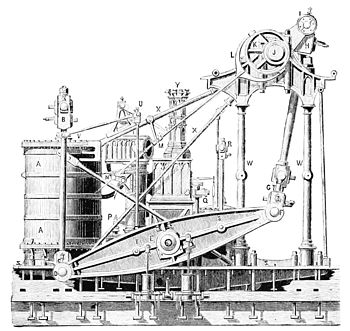Western rivers, all steamers were then propelled, as they are still, by condensing engines. The instrument of propulsion was also, even in Stevens's own boats after his earlier experiments, the paddle-wheel. The use of the screw did not become general, even in deep water, until within the last twenty years.
96. The steam-engine in most general use for sea-going ships when the introduction of the screw compelled its withdrawal, with the paddle-wheel which it drove, was that shown in Fig. 57, which represents the side-lever engine of the steamer Pacific, as designed by Charles W. Copeland.
In the sketch, A is the steam-cylinder; B C the side-rods, or links, connecting the cross-head in the piston-rod with the end-centres

Fig. 57.—The Side-Lever Engine, 1849.
D, of the side-lever D E F, which vibrates about the main centre E, like the overhead beams. A cross-tail at G is connected with the side-lever and with the connecting-rod G H, which latter communicates motion to the crank I J, turning the main shaft J. The air-pump and condenser are seen at O M. This engine was one of the earliest and best examples of the type, and perhaps the first ever fitted with a framing of wrought-iron.
97. After the experiments of Stevens, we find no evidence of the use of the screw, although schemes were proposed and various forms were even patented, until about 1836.
In 1836 Francis P. Smith, an English farmer, who had become
